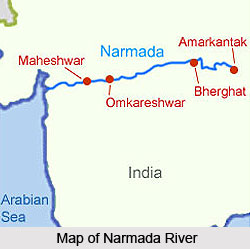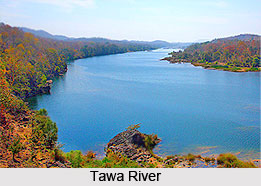 The tributaries of River Narmada are of great importance in Central India as they provide an important source of water, irrigation and other resource based activities. The Narmada River is one of the most important rivers situated in central India and the fifth largest river in the sub-continent. It forms a boundary between North and South India and flows in a westward direction for over a length of 1,312 kms before draining through the Gulf of Khambhat into the Arabian Sea. Among the major tributaries of the Narmada river are the Hallon River, Banjar River, Barna River and Tawa River. When river Narmada emerges from the Marble Rocks the river enters its first fertile basin. This basin extends about 320 km with an average width of 35 km in the south. The northern part of the valley is the Barna-Bareli plain, where the Barna River flows. The Tawa River flowing through central India is the longest tributary of the Narmada River. It originates in the Satpura Mountain Range of the Betul district and Chhindwara district of Madhya Pradesh.
The tributaries of River Narmada are of great importance in Central India as they provide an important source of water, irrigation and other resource based activities. The Narmada River is one of the most important rivers situated in central India and the fifth largest river in the sub-continent. It forms a boundary between North and South India and flows in a westward direction for over a length of 1,312 kms before draining through the Gulf of Khambhat into the Arabian Sea. Among the major tributaries of the Narmada river are the Hallon River, Banjar River, Barna River and Tawa River. When river Narmada emerges from the Marble Rocks the river enters its first fertile basin. This basin extends about 320 km with an average width of 35 km in the south. The northern part of the valley is the Barna-Bareli plain, where the Barna River flows. The Tawa River flowing through central India is the longest tributary of the Narmada River. It originates in the Satpura Mountain Range of the Betul district and Chhindwara district of Madhya Pradesh.
Banjar River
The Banjar River is the major tributary of the Narmada. It passes through the Mandla District in the state of Madhya Pradesh. The catchment area of the river contains some of the best Sal forests of the district. The Kanha National Park is situated in the upper courses of Narmada, along the banks of the Banjar River. It is almost 18 Kms from Mandla features several wild animals including the tiger.
 Tawa River
Tawa River
The longest tributary of the Narmada is the Tawa River. The river is one hundred and seventy two kilometers in length. It has its origins in the Satpura range of the Betul and Chhindwara districts of Madhya Pradesh. It continues to flow in a north-westerly direction from this point onwards and enters the village of Bandra Bhan in Hoshangabad district where it merges with the Narmada River.
Barna River
The Barna River flows along the Barna-Bareili plain. The banks of the river are about 12 metres high. The Hiran, the Barna, the Choral, the Karam and the Lohar are the significant tributaries joining Narmada from the north.
Halon River
The Halon valley falls in Balaghat district. The Halon River also flows across the Kanha National Park.
Thus discussed above are the important tributaries of the Narmada River.















